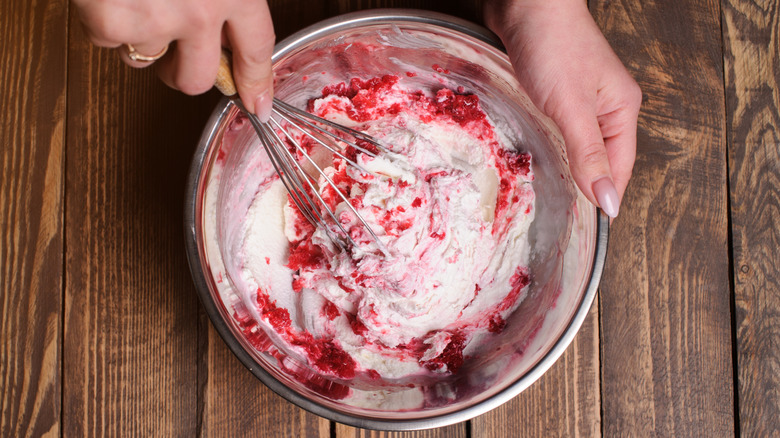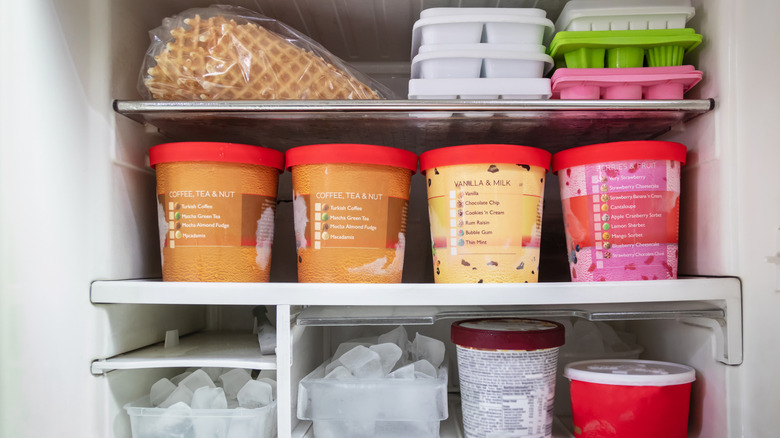The Secret Ingredient That Makes Homemade Ice Cream As Smooth As Store-Bought
Between figuring out sourdough starters and making your own three-ingredient pickles, forgoing certain grocery store items for quality crafted foods usually reserved for bygone eras seems to be the ironic way of the future. You can add ice cream to that list, with a gummy addition — gelatin. This secret superhero ingredient will ensure your homemade ice cream is just as smooth as what you pick up from the store. Food Republic reached out to Zac Young, TV personality on Food Network and owner of Sprinkletown Donuts & Ice Cream.
Young explained, "Gelatin is a great stabilizer for ice creams and especially sorbets, since gelatin 'traps' water, resulting in smaller ice crystals. Similarly, using thickeners like corn starch or xanthan gum [helps] mitigate water content." Smaller ice crystals will mean better overall texture and slower melting.
To include gelatin in your ice cream, you'll need one packet for every six cups of your ice cream mixture. You'll bloom the gelatin over low heat with a ¼ cup of your not-yet-ice cream, stirring until fully dissolved. Then, stir that separated mixture back into the rest before churning and freezing. Corn starch or xanthan gum makes a vegetarian-friendly option instead of gelatin. You only need ½ teaspoon of xanthan gum or one tablespoon and a teaspoon of cornstarch for roughly every four cups of liquid.
Best bases for your ice cream
Chef Zac Young also outlined the best beginner tip when building the flavors for your ice cream. "It's all about the base. You want something that is balanced in terms of sugar, fat, and liquid. Something with any form of stabilizer, whether it be cream cheese, cornstarch, xanthan gum, gelatin, [or] agar-agar," Young said.
As far as dairy goes, a tried and true method that he greatly appreciates is condensed milk. He called it "a genius ingredient because it provides not only sugar but dairy in a way that contains very little water, so you get a super-smooth product without large ice crystals."
His go-to base of choice isn't just whole or 2% milk; instead, he uses a combination of milk, cream, and powdered milk. This is a great way to balance your dairy without running the risk of having too much water and a less-than-desirable texture post-freeze.
Another way to improve texture is to add eggs to your base — even a simple vanilla ice cream recipe will call for six. "In ice creams, eggs provide both fat in the yolks, and a thickener by way of the proteins in the whites. To make an ice cream without eggs, you need to add fat back in as well as a thickener [or] binder in the form of a stabilizer (xanthan gum, gelatin, starches)," Young informed us.
Tips for preparing and storing your homemade ice cream
If you don't have an ice cream maker, don't opt for a plastic bag — try adjusting your recipe. According to expert Zac Young, "Without an ice cream machine, I prefer to make a semifreddo or frozen mousse — same airy [and] creamy texture, different process."
Semifreddo, an Italian dessert, is a cross between ice cream and mousse, made by gently folding whipped cream into a custard base prior to freezing. The genius behind semifreddo is that it's served as slices rather than scoops, making them easy to enjoy as chocolate-covered semifreddo bars. Mousses also freeze remarkably well and won't involve the churning that's typical via an ice cream machine.
When it comes to storing your now expertly crafted confections, you don't want your hard work to be for naught by risking freezer burn or absorption of auxiliary freezer flavors. Young considers temperature fluctuation and air ice cream's two biggest enemies. To mitigate these foes, he advised using insulated or double-walled containers. You also want something air-tight as Young warned, "Freezers can smell weird, and because of ice cream's fat content, it will absorb any of those flavors."



